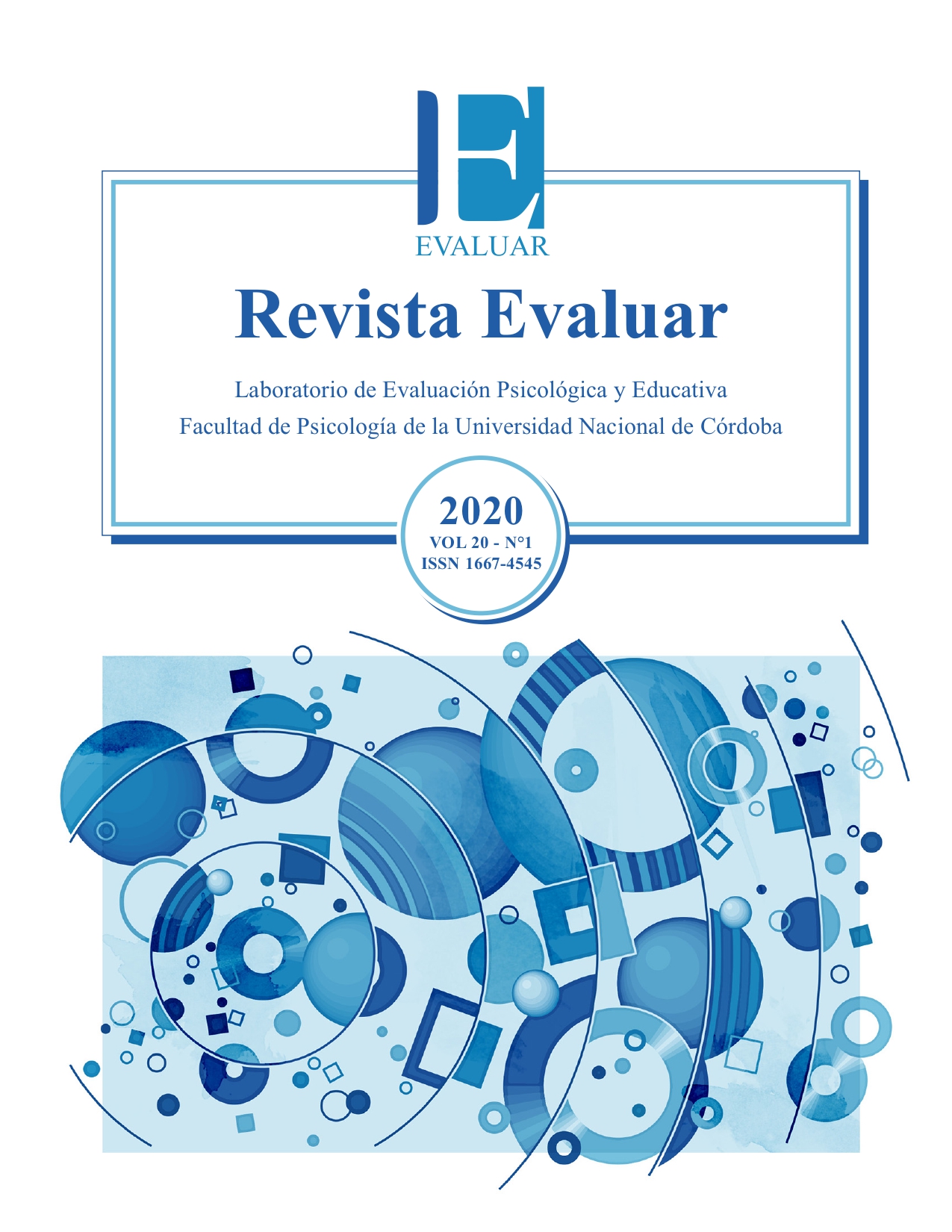Dimensional Structure of the Clinical Outcomes in Routine Evaluation - Outcome Measure (CORE-OM) in Mexican University Students
DOI:
https://doi.org/10.35670/1667-4545.v20.n1.28485Keywords:
CORE-OM, psychological distress, university, CFA, DIFAbstract
This work verifies the dimensional structure of the Clinical Outcomes in Routine Evaluation - Outcome Measure (CORE-OM; Evans et al., 2000) through a quantitative-cross-sectional study in a sample of 466 university students who were selected by convenience sampling. 181 ages 18 to 30 who had requested psychological attention; and 285 ages 17 to 29 who were not seeking care. Through exploratory and confirmatory factor analyses,three dimensions for the instrument were identified, which presented adequate levels of internal consistency. This substantially replicates the previous results of the original version. Statistically significant differences were found in relation to sex, as well as of the consulting and non-consulting population. Differential item functioning (DIF) was carried out to explore these differences, and five items were found in the first category and three in the second. The internal structure of CORE-OM explores a wide range of symptoms of psychological distress and it is useful for evaluation in young university students.
Downloads
References
Auerbach, R., Alonso, J., Axinn, W., Cuijpers, P., Ebert, D., Greif, J., … Bruffaerts, R. (2016). Mental disorders among college students in the World Health Organization World Mental Health Surveys. Psychological Medicine, 46(14), 2955-2970. doi: 10.1017/S0033291716001665
Barkham, M., Gilbert, N., Connell, J., Marshall, C., & Twigg, E. (2005). Suitability and utility of the CORE-OM and CORE-A for assessing severity of presenting
problems in psychological therapy services based in primary and secondary care settings. The British Journal of Psychiatry, 186(3), 239-246. doi: 10.1192/bjp.186.3.239
Beck, A., Burdett, M., & Lewis, H. (2015). The association between waiting for psychological therapy and therapy outcomes as measured by the CORE-OM. British Journal of Clinical Psychology, 54(2), 233-248. doi: 10.1111/bjc.12072
Benjet, C., Borges, G., Medina-Mora, M. E., Méndez, E., Fleiz, C., Rojas, E., & Cruz, C. (2009). Diferencias de sexo en la prevalencia y severidad de trastornos psiquiátricos en adolescentes de la Ciudad de México. Salud Mental, 32(2), 155-163. Recuperado de https://revistasaludmental.mx/index.php/salud_mental/index
Bentler, P. M. (1992). On the fit of models to covariances and methodology to the Bulletin. Psychological Bulletin, 112(3), 400-404. doi: 10.1037/0033-2909.112.3.400
Berenzon, S., Lara, M. A., Robles, R., & Medina-Mora, M. E. (2013). Depresión: Estado del conocimiento y la necesidad de políticas públicas y planes de acción en
México. Salud Pública de México, 55(1), 74-80. doi: 10.1590/s0036-36342013000100011
Branney, P., & Barkham, M. (2006). Core outcomes in psychosexual therapy: A feasibility study of the CORE-OM. Sexual and Relationship Therapy, 21(1), 15-26. doi: 10.1080/14681990500281414
Byrne, B. (2009). Structural equation modeling with AMOS: Basic concepts, applications and programming (2ª ed.). New York, NY: Routledge.
Campo-Arias, A., & Oviedo, H. (2008). Propiedades psicométricas de una escala: La consistencia interna. Revista de Salud Pública, 10(5), 831-839. doi: 10.1590/s0124-00642008000500015
Campo-Arias, A., Herazo, E., & Oviedo, H. (2012). Análisis de factores: Fundamentos para la evaluación de instrumentos de medición en salud mental. Revista Colombiana de Psiquiatría, 41(3), 659-671. doi: 10.1016/s0034-7450(14)60036-6
Casey, P., Cowan, P., Cowan, C., Draper, L., Mwamba, N., & Hewison, D. (2017). Parents as partners: A U.K. trial of a U.S. couples-based parenting intervention for at-risk low-income families. Family Process, 56(3), 589-606. doi: 10.1111/famp.12289
Connell, J., Barkham, M., & Mellor-Clark, J. (2007). CORE-OM mental health norms of students attending university counselling services benchmarked against an age-matched primary care sample. British Journal of Guidance & Counselling, 35(1), 41-57. doi: 10.1080/03069880601106781
CORE IMS. (2001). Reino Unido: In CORE Information Management Systems. Recuperado el 2 de febrero de 2014 de https://www.coreims.co.uk
Dias-Sales, C. M., de Matos-Moleiro, C. M., Evans, C., & Gomes-Alves, P. C. (2012). Versão portuguesa do CORE-OM: Tradução, adaptação e estudo preliminar das suas propriedades psicométricas. Revista de Psiquiatria Clínica, 39(2), 54-59. doi: 10.1590/S0101-60832012000200003
Díaz, D., Rodríguez-Carvajal, R., Blanco, A., Moreno-Jiménez, B., Gallardo, I., Valle, C., & van Dierendonck, D. (2006). Adaptación española de las escalas de bienestar psicológico de Ryff. Psicothema, 18(3), 572-577. Recuperado de https://www.psicothema.com
Echevarría, H. D. (2016). Los diseños de investigación cuantitativa en psicología y educación. Río Cuarto: UniRío. Recuperado de https://www.unrc.edu.ar
Elfström, M., Evans, C., Lundgren, J., Johansson, B., Hakeberg, M., & Carlsson, S. (2013). Validation of the Swedish version of the Clinical Outcomes in Routine Evaluation Outcome Measure (CORE-OM). Clinical Psychology and Psychotherapy, 20(5), 447-455. doi: 10.1002/cpp.1788
Elosua-Oliden, P. (2003). Sobre la validez de los tests. Psichotema, 15(2). 315-321. Recuperado de https://www.psicothema.com
Espíndola-Hernández, J. G., Morales-Carmona, F., Díaz, E., Pimentel, D., Meza, P., Henales, C., … Ibarra, C. (2006). Malestar psicológico: Algunas de sus manifestaciones clínicas en la paciente gineco-obstétrica hospitalizada. Perinatología y Reproducción Humana, 20(4), 112-122. Recuperado de https://www.medigraphic.com
Evans, C., Connell, J., Barkham, M., Margison, F., McGrath, G., Mellor-Clark, J., & Audin, K. (2002). Towards a standardised brief outcome measure: Psychometric
properties and utility of the CORE-OM. The British Journal of Psychiatry, 180(1), 51-60. doi: 10.1192/bjp.180.1.51
Evans, C., Mellor-Clark, J., Margison, F., Barkham, M., Audin, K., Connell, J., & McGrath, G. (2000). CORE: Clinical Outcomes in Routine Evaluation. Journal of Mental Health, 9(3), 247-255. doi: 10.1080/jmh.9.3.247.255
Fleiz-Bautista, C., Villatoro-Velázquez, J., Medina-Mora-Icaza, M. E., Moreno-López, M., Gutiérrez-López, M. L., & Oliva-Robles, N. (2012). Sociodemographic and personal factors related to depressive symptomatology in the Mexican population aged 12 to 65. Revista Brasileira de Psiquiatria, 34(4), 395-404. doi: 10.1016/j.rbp.2012.03.004
Forero, C., Maydeu-Olivares, A., & Gallardo-Pujol, D. (2009). Factor analysis with ordinal indicators: A Monte Carlo study comparing DWLS and ULS estimation. Structural Equation Modeling: A Multidisciplinary Journal, 16(4), 625-641. doi: 10.1080/10705510903203573
Freeman, D., & Freeman, J. (2013). The stressed sex: Uncovering the truth about men, women, and mental health. Oxford, Reino Unido: Oxford University.
Guevara-Ruiseñor, E. S. (2008). Vida sexual y malestar emocional. Las contradicciones de la modernidad. REMO, 6(14), 2-11. Recuperado de https://remo.ws
IBM Corporation. (2012). IBM SPSS Statistics for Windows (Version 21.0) [software de cómputo]. Armonk, NY: IBM.
Jansz, J. (2000). Masculine identity and restrictive emotionality. En A. Fischer (Ed.), Gender and Emotion. Social Psychological Perspectives, pp. 166-186. Cambridge,
Reino Unido: Cambridge University. doi: 10.1017/cbo9780511628191.009
Juhová, D., Řiháček, T., Cígler, H., Dubovská, E., Saic, M., Černý, M., … Evans, C. (2018). Česká adaptace dotazníku CORE-OM: Vybrané psychometrické charakteristiky. Československá Psychologie, 62(1), 59-74.
López-Bárcena, J. J., & González de Cossío-Ortiz, M. G. (2005). Modelo universitario de salud integral, en la Universidad Nacional Autónoma de México. FACMED, 48(6), 224-231. Recuperado de https:// www.revistas.unam.mx
Lyne, J., Barret, P., Evans, C., & Barkham, M. (2006). Dimensions of variation on the CORE-OM. The British Journal of Clinical Psychology, 45(2), 185-203. Recuperado de https://onlinelibrary.wiley.com/journal/20448260
Mantel, N., & Haenszel, W. (1959). Statistical aspects of the analysis of data from retrospective studies of disease. Journal of the National Cancer Institute, 22(4), 719-748. doi: 10.1093/jnci/22.4.719
Margison, F. R., Barkham, M., Evans, C., McGrath, G., Mellor-Clark, J., Audin, K., & Connell, J. (2000). Measurement and psychotherapy. Evidence-based practice and practice-based evidence. The British Journal of Psychiatry, 177(2), 123-130. doi: 10.1192/bjp.177.2.123
Mellor-Clark, J., Barkham, M., Connell, J., & Evans, C. (1999). Practice-based evidence and standardized evaluation: Informing the design of the CORE system. European Journal of Psychotherapy and Counselling, 2(3), 357-374. doi: 10.1080/13642539908400818
Navascués, A., Calvo-Medel, D., & Bombin-Martín, A. (2016). Efectos del bienestar subjetivo y psicológico en los resultados terapéuticos de un hospital de día. Acción Psicológica, 13(2), 143-156. doi: 10.5944/ap.13.2.15818
Otzen, T., & Manterola, C. (2017). Técnicas de muestreo sobre una población de estudio. International Journal of Morphology, 35(1), 227-232. doi: 10.4067/S0717-95022017000100037
Organización Mundial de la Salud. (2013). Salud mental: Un estado de bienestar. Recuperado el 1 de diciembre de 2013 de https://origin.who.int
Penfield, R. (2009). DIFAS 5. Differential Item Functioning Analysis System. Computer Program Exchange (Versión 1.00) [software de cómputo]. Recuperado de https://soe.uncg.edu/academics/departments/erm/erm-software
Penfield, R. (2013). DIFAS 5.0. Differential Item Functioning Analysis System. User’s Manual. Recuperado de https://soe.uncg.edu
Penfield, R. D., & Algina, J. (2006). A generalized DIF effect variance estimator for measuring unsigned differential test functioning in mixed format tests. Journal of Educational Measurement, 43(4), 295-312. doi: 10.1111/j.1745-3984.2006.00018.x
Pérez, E., & Medrano, L. (2010). Análisis Factorial Exploratorio: Bases conceptuales y metodológicas. Revista Argentina de Ciencias del Comportamiento, 2(1), 58-66. Recuperado de https://www.revistas.unc.edu.ar
Pérez-Padilla, M. L., Ponce-Rojo, A., Hernández-Contreras, J., & Márquez-Muñoz, B. A. (2010). Salud mental y bienestar psicológico en los estudiantes universitarios
de primer ingreso de la Región Altos Norte de Jalisco. Revista de Educación y Desarrollo, 14, 31-37. Recuperado de http://www.cucs.udg.mx/revistas/edu_desarrollo
Perry, T., Barkham, M., & Evans, C. (2013). The CORE-OM and CORE-OM (SV) in secure settings: A template analysis of the experiences of male patients and their staff. The British Journal of Forensic Practice, 15(1), 32-43. doi: 10.1108/14636641311299068
Ramada-Rodilla, J. M., Serra-Pujadas, C., & Delclós-Clanchet, G. L. (2013). Adaptación cultural y validación de cuestionarios de salud: Revisión y recomendaciones
metodológicas. Salud Pública de México, 55(1), 57-66. doi: 10.1590/s0036-36342013000100009
Rivera-Ledesma, A., Caballero-Suárez, N., Pérez-Sánchez, I., & Montero-López-Lena, M. (2013). SCL-90: Distrés psicológico, género y conductas de riesgo. Universitas Psychologica, 12(1), 105-118. doi: 10.11144/javeriana.upsy12-1.dpgc
Rosales-Pérez, J. C., Córdova-Osnaya, M., & Ramos-Clatempa, R. (2012). Ideación suicida en estudiantes mexicanos: Un modelo de relación múltiple con variables
de identificación personal. Psicología y Salud, 22(1), 63-74. Recuperado de https://psicologiaysalud.uv.mx/index.php/psicysalud/index
Trujillo-Terán, L. A. (2012). Análisis psicométrico preliminar de la versión en español del CORE-OM: Clinical Outcomes in Routine Evaluation-Outcome Measure
(Tesis de maestría). Universidad de Barcelona, España. Recuperado de https://babel.banrepcultural.org
Uji, M., Sakamoto, A., Adachi, K., & Kitamura, T. (2012). Psychometric properties of the Japanese version of the Clinical Outcomes in Routine Evaluation-Outcome
Measure. Comprehensive Psychiatry, 53(5), 600-608. doi: 10.1016/j.comppsych.2011.09.006
Vargas-Fallas, K., & Prada-Villalobos, S. (2013). Validación del instrumento: Resultados Clínicos en Evaluación de Rutina (CORE). Revista Humanitas, 10(10), 33-44. Recuperado de https://www.unirioja.es
Viliū-nienė, R., Evans, C., Hilbig, J., Pakalniškienė, V., Danilevičiūtė, V., Laurinaitis, E., & Navickas, A. (2013). Translating the Clinical Outcomes in Routine Evaluation Outcome Measure (CORE-OM) into Lithuanian. Nordic Journal of Psychiatry, 67(5), 305-311. doi: 10.3109/08039488.2012.745599
Zhang, Y., Hu, J., Evans, C., Jin, L., Wu, M., Wang, C., … Chen, G. (2019). Psychometric properties of the Chinese version of the Clinical Outcomes in Routine Evaluation-Outcome Measure (CORE-OM). British Journal of Guidance & Counselling, 1-11. doi: 10.1080/03069885.2019.1682120
Downloads
Published
Versions
- 2020-07-04 (3)
- 2020-07-04 (2)
- 2020-05-05 (1)
How to Cite
Issue
Section
License

This work is licensed under a Creative Commons Attribution 4.0 International License.
Revista Evaluar aplica la Licencia Internacional de Atribuciones Comunes Creativas (Creative Commons Attribution License, CCAL). Bajo esta licencia, los autores retienen la propiedad de copyright de los artículos pero permiten que, sin que medie permiso de autor o editor, cualquier persona descargue y distribuya los artículos publicados en Evaluar. La única condición es que siempre y en todos los casos se cite a los autores y a la fuente original de publicación (i.e. Evaluar). El envío de artículos a Evaluar y la lectura de los mismos es totalmente gratuito.




_(3).jpg)



.jpg)



